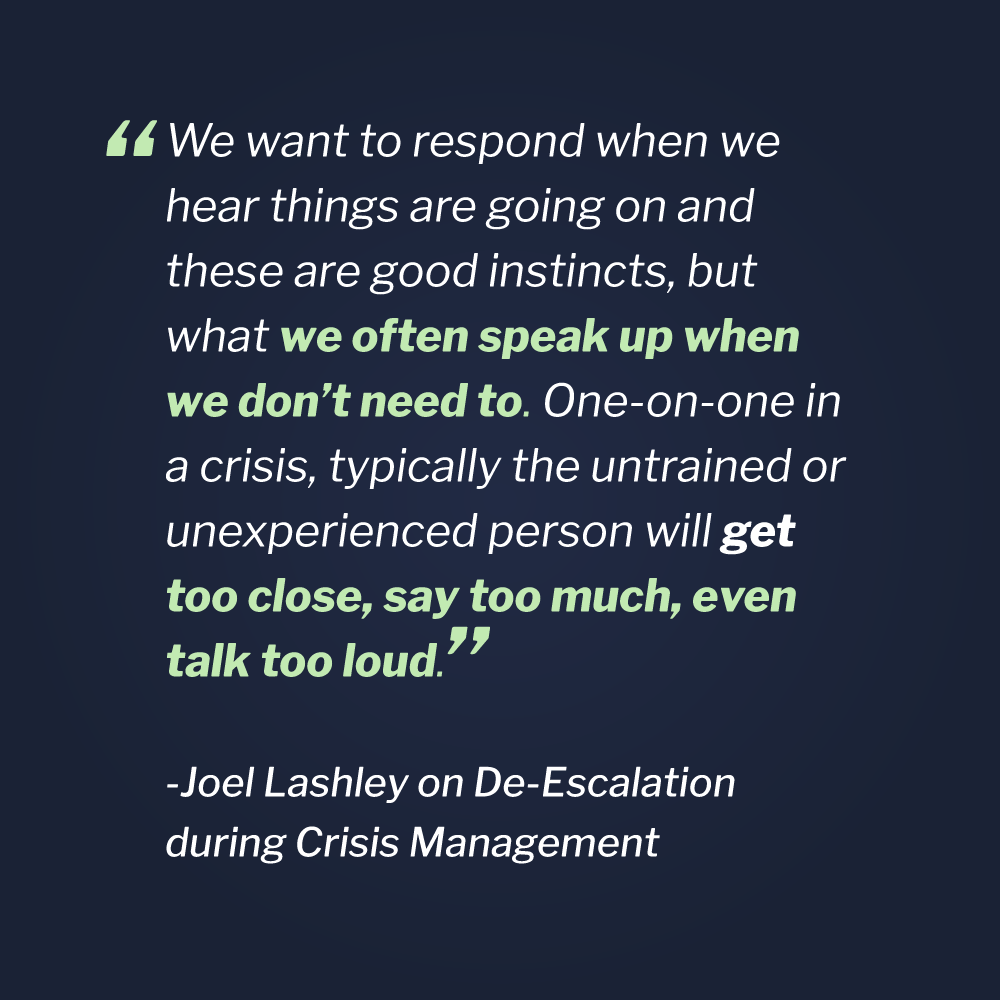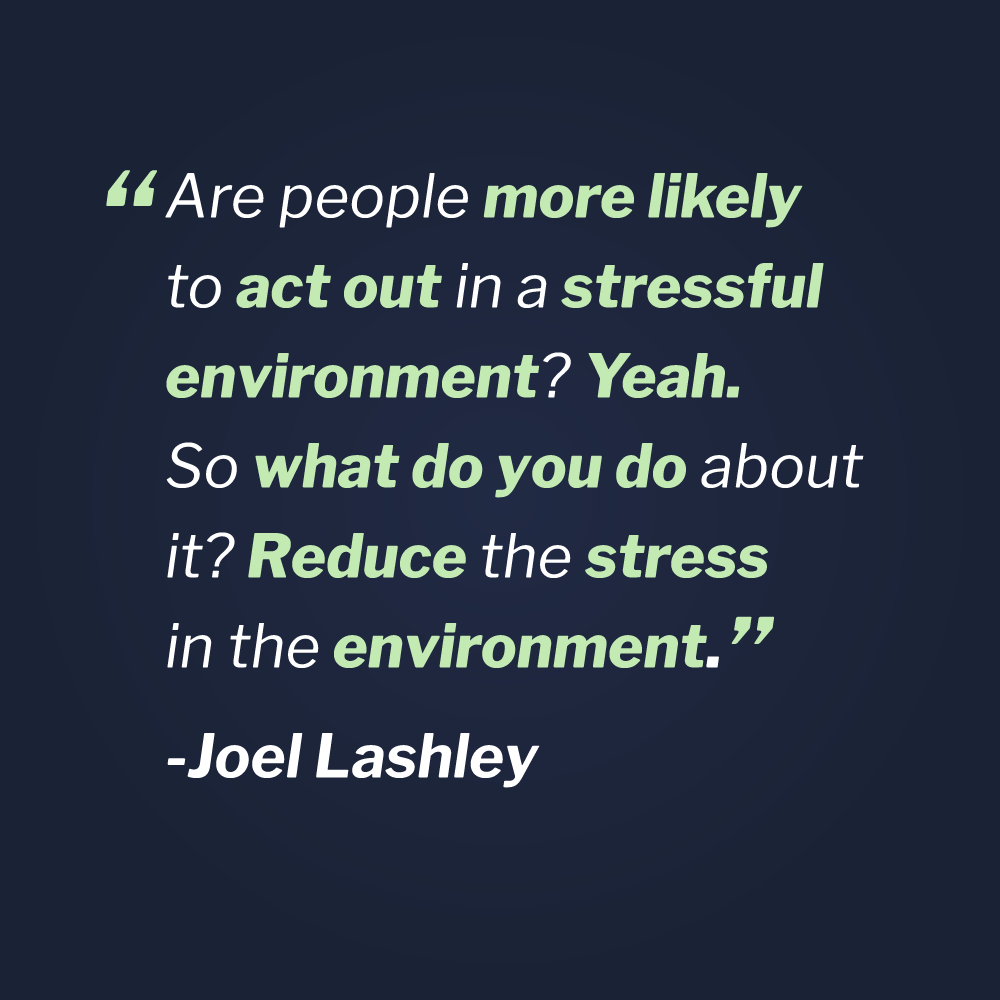“Train Early and Often” - Episode 5
Host: Al Oelschlaeger
Guest: Joel Lashley
Subscribe to our podcast on Apple Podcasts, Stitcher, Google Play or YouTube.
Joel Lashley, self-professed “violence nerd,” sits down with Al Oelschlaeger again for another one-on-one examination of violence in the workplace. If violence in the workplace is truly on the rise, what skills are the most prepared employees equipped with? Lashley and Oelschlaeger cover the importance of training employees early and often on de-escalating situations and some things to look for when assessing a workplace’s potential for violence.
Allen Oelschlaeger: I’m here with Joel Lashley. Joel, why don’t you quickly introduce yourself, and then we’ll get into it?
Joel Lashley: Hi. Well, like you said, I’m Joel Lashley. I’ve worked in crisis intervention and health care. I was safety and security for about 30 years, and I’ve been a consultant pretty much since the beginning.
Allen: Yep. We probably met, I don’t know, a few years ago; I think, Joel. I think you describe yourself as the violence nerd.
Joel: Yeah.
Allen: So tell me a little bit more about that.
Joel: Well, most of my career I’ve had to deal with people in different phases of crisis. I had to manage a lot of violence, how to prevent it, how to survive it. I studied a lot about violence, trained a lot about how to manage violence, prevent violence. Crashed and burned a few times, had a lot of successes, had a lot of great mentors over the years. It’s kind of been my passion and in my professional life, I’m definitely a violence nerd.
Allen: There we go. Whenever we talk, it seems like you have the practical experience from your job in dealing with this issue in real life, but it seems like you’ve also just paid attention to the literature and what’s going on academically.
Joel: Yeah. Yeah, that’s true. I mean, it’s just like any other job. I work in psychiatry, in supportive psychiatric facilities and special needs schools. I’ve trained all over the state and in parts of the country; in all kinds of different environments, even jails and police that work in the community. So I’ve learned a few things over the years, and just like in any other profession, you have to keep abreast of what’s out there in academia. I try to be an expert on what the studies are. Like I said, I’ve been blessed with some of the best mentors in the field that have trained me over the years, and even in some cases worked alongside them.
Allen: Yeah. Well, you have a story to tell. So why don’t you tell that story? Let’s talk about how to embed it in that story, how to better manage conflict.
Joel: Well, I always teach using stories. It seems to me I get a new one every week. People say, “You should write a book.” I could probably write an encyclopedia, so I like to use simple parables that kind of illustrate an issue. This one will seem familiar to a lot of people that work in human services, psychiatry, in the medical field, or a teacher or corrections officer.
De-escalating the Situation
Joel: I was working in support of a special needs school and a team member had just de-escalated a child successfully who was acting out pretty significantly.
Allen: Just for the audience, help me. It’s a word that I didn’t start using until a few years ago. So de-escalate means what? The kid was acting out, and then what happened?
Joel: De-escalate is an overused word. I get that, but what we’re trying to do is take someone from a high emotional state to a lower emotional state, a more manageable state back to their baseline. Everybody’s personality is different, but everybody has a baseline and when they’re in crisis, they’re not making the best decisions. They’re not behaving in the best way, and the cycle goes all the way up to violence. To threatening behavior, to anti-social behavior, all the way up to violence. We’re taking someone from that level of agitation down to a manageable place down to where they are normally.
Allen: Okay. There was a kid that was acting out-
Joel: He was-
Allen: High emotions and-
Joel: Yeah. Lots of yelling, cursing, refusing to take medications that were prescribed and such. Actually, the medical professional that was working with him had managed to de-escalate him rather successfully and got him down to a place where he was willing to cooperate and voluntarily take his prescribed medications. So he had calmed down. He wasn’t verbalizing, he wasn’t acting out in any way. He was starting to cooperate. He was starting to go into what we call recovery. He’s gaining his normal rate of respiration. He’s starting to calm down. He’s starting to collect himself, and he’d actually gotten to the phase where he was starting to cooperate. Okay? He’s going to take his medication.
Joel: The nurse had got him his prescribed medications and a cup of water, and he placed the pills in his mouth. When another school worker came around the corner and recognized the kid and said, you know, “Hey Johnny, what’s going on? What’s got you so upset today?” In that instant, the kid escalated again, spit his pills out in the nurse’s face and just flipped out. That’s something that sounds really familiar to a lot of people.
Allen: Yeah.
Joel: When you work in this field, we all want to help. We’re nurturers, we’re problem solvers, we want to fix things and we hear things are going on. We want to respond and these are good instincts, but what we do naturally often is speak up when we don’t need to. One-on-one in a crisis, typically the untrained or unexperienced person will get too close, say too much, even talk too loud.
fix things and we hear things are going on. We want to respond and these are good instincts, but what we do naturally often is speak up when we don’t need to. One-on-one in a crisis, typically the untrained or unexperienced person will get too close, say too much, even talk too loud.
Joel: When working in a team, we act just like family members do. We want to crowd around. We want to rationalize, we want to problem solve, we want to fix, we want to set limits. People who are in crisis are recovering from crisis. They’re still in the cycle. They don’t want to hear all that. One voice is communication. Two is noise. Three is chaos.
Allen: Yeah.
Joel: Right?
Allen: So in this case, here you have this kid that’s doing pretty well and this second person’s coming in, and basically just getting it all goofed up again.
Joel: Getting it all goofed up again. When you’re in recovery, they don’t want to explain themselves. They don’t want to hear interrogatory questions. It’s not that time for that. It’s not time to ask, “Hey, what’s got you upset today?”, when they’re in recovery. Those questions come later, right?
Allen: Yeah.
Joel: Maybe even during; they may be appropriate during the de-escalation phase. When we’re … Say we might even be using persuasion. “The reason I’m here is you’re really upset and you’re cursing. Can you tell me what’s got you so upset today?” Followed up by that reassurance, that connection phase where we were saying, “How can I help? I want to help you. You’re safe with me. Explain to me what the problem is so I can help,” right?
Allen: Yeah. Yeah.
Joel: When we get to recovery, we don’t want to open that door again. When we walk up and a person is not in crisis, it’s not the time for us to walk up and glom onto it.
Allen: Yeah.
Joel: That’s often the case. So one voice is more than just a concept at the point of impact. When three people are talking and we say, “One voice,” to remind all the rest of us that we’re doing a very human thing; we’re all talking at once, which is just gasoline on the fire for the person in crisis.
Allen: Joel, where did this one voice thing … Do you know where that came from? Is that something from your experience or was that-
Joel: No, it’s not something from my experiences, it preceded me. I know they were using it … There was a nurse that used it quite a bit. I don’t recall her name in the Milwaukee County area. She was a county nurse, I believe.
Allen: But local, not necessarily a national-
Joel: You see it here and there. There’s been studies on it at different universities, different acronyms that people try to make out of that. “O” stands for only, and that kind of thing.
Allen: Right.
Joel: Really, it’s just … To me that complicates the whole concept. It’s a very simple concept. It’s that one voice can de-escalate somebody. Two voices distracts them.
Allen: Yeah, and three just creates chaos.
Joel: Three just makes chaos. Yeah.
Allen: Obviously, the key here is that the training needs to be across the spectrum here so that everybody involved understands that, and if somebody-
Joel: Oh, yeah.
Allen: One, they shouldn’t be jumping in at all.
Joel: That’s the irony of it. It’s not an individual process, but when you have one person communicating, the other team members have to know their role. One is to leave well enough alone. Don’t fix a problem that doesn’t exist. Don’t interfere with the process. Right? If you’re not getting anywhere, and someone else can step in at that point and you do a handoff, then back out.
Allen: Yeah.
Joel: You still need team members to respond for safety. Sometimes that means out of sight, out of mind, just around the corner. Sometimes that means just standing nearby and modeling appropriate behavior, but team members need to know where to stand so they’re not escalating that behavior, so they’re not creating agitation. We need to know when to interject and when not to, because this is a very common problem in institutions. One person seems to be doing okay, and the second person shows up and everything goes south. Your training has to be consistent. Everyone has to know the system, because if one person is doing it and another person is doing it another way, that’s a big problem.
Allen: Well, Joel, as you know, I’ve heard probably a dozen stories from you like this, and it’s pretty universal what the outcome is. You always have that one person that just doesn’t know the drill, and they come in and you’re starting all over again.
Joel: That’s all it takes. Yeah. You can learn these things through experience, but it takes about 20 years.
Allen: Right. Right.
Joel: That’s the problem. I had a conversation with a nursing manager at a hospital the other day, and she says, “You know what the problem is?”, she said, “My first shift nurses, they’re all really good at this. But the second shift ones aren’t so much.” So I said, “Well, what’s the difference between the two?” She said, “Well, the first shift nurses have been here 20 years and the second shift nurses are all new.”
Allen: Right. Exactly.
Joel: Well, there’s your problem.
Allen: Yeah.
Joel: Proper training captures experience, encapsulates it, translates it and transfers it to someone else. Good training has to be both experiential; that means with scenario based training, paradigms that they can understand. That’s why we tell stories. Things they can practice and learn, and it also has to be conceptual. To tell people, “Well, if you speak in one voice clearly and then another person …” One voice is a concept, right?
Allen: Yeah.
Joel: Inconsistency is the enemy of peace, is a concept. It has to be each point is captured conceptually and then taught experientially so they can internalize it, and it becomes natural to them. That’s how you can transfer that 20 years of experience to less experienced workers, so that hopefully you can reduce that time because we don’t have 20 years to wait for people to learn how to do their job.
Allen: Joel, have I ever told you the Zig Ziglar story about training? I don’t know if you know the name Zig Ziglar. He was a motivational speaker years-
Joel: Yeah, I’ve heard you mention him.
Allen: I heard him once live and he said, “Yeah, I was talking to this …” It was a business environment, not a healthcare environment, but talking to the CEO and he’s talking to him about training. The CEO’s complaining, going, “God darn it. I do this training and spend all this money, and then people leave and I’ve just wasted my money.” Zig looks at the CEO and said, “You know what’s worse than that, sir?” The guy goes, “What’s that?” And he goes, “You don’t train them and they stay.”
Joel: Oh, I like that.
Allen: Right? Right.
Joel: I love that. Yeah.
Non-Verbal Communication to Aid in De-Escalation
Allen: Yeah. So back to your story. This person, obviously she walks up, she knows this kid. So she recognizes … What should she have done instead?
Joel: She should have modeled appropriate behavior, standing in a calm way and a reassuring way. Placing your hands in a way that we’re not threatening, placing her feet in a way that presented a safe persona, but also the ability to defend herself or to assist if need be. She needs to model the appropriate expression. People in crisis don’t want to be smiled at. That’s a very common problem with nervous smilers, or that person that’s been told, “Always smile.” But if I’ve heard this, I’ve heard it a million times in a hospital or another environment. It’s, “What are you smiling at? Do you think this is funny?”
Allen: Right.
Joel: So we have to train them to wear the appropriate expression, which in that case would be concern, confidence. Right?
Allen: Yeah.
Joel: A message that says, “I’m in control and you’re safe with me.” That has to be part of that experiential training.
Allen: And not a lot of words in this case.
Joel: No words.
Allen: No words.
Joel: We’re speaking with our expression, with our body language, and the message just has to be that I’m on your side. I’m on the caseworker’s side. I am here if needed, but I’m not going to interfere.
Allen: Yeah. Yeah. Beautiful. Obviously Joel, we want to do more of these, and this will be … So audience, come back often because we’re going to be talking to Joel a lot. Like I said, he’s had years of experience, training, experiential real life stuff. He made reference to the fact that he wants to write another book, but he’s already written one. Joel, why don’t you just give a quick summary of the first book you wrote?
Joel: Well, the first bit was part of the confidence and conflicts series, based on that social contract concept that environments can be conducive to violence, they can be conducive to peace, they can be conducive to cooperation, or the opposite. So the tagline on the title was creating environments of care that are incompatible with violence. Is it something that we can do in our hospitals, and for that matter, in jails or schools or stores that make them more or less compatible with conflict? The idea is always to create an environment that’s incompatible with conflict. It doesn’t fit here.
Allen: Right, exactly.
Joel: The gross example is being in a bar. A fist fight kind of fits there, especially depending on the bar.
Allen: Right.
Joel: In church, it doesn’t fit there.
Allen: Right.
Joel: So what is it about those dynamics that makes one sort of behavior socially acceptable and not in another? If we could figure out how to do that in a hospital, and I think we’ve successfully done that, that’s the premise of the book. How do we do that?
Are Acts of Violence on the rise?
Allen: Well, two things there. One is … Joel already told one story, but what I loved about the book, because I actually helped edit it, but it’s filled with stories. It’s stories from Joel’s past that all have a point to be made. But, Joel. Yesterday, literally, I was on the phone with a guy that does … I don’t know what would be his role. He has clients that are healthcare clients and he has an insurance product, and so he’s talking to healthcare senior executives from all over the country. So I asked him the question, and I don’t know if you’ve seen this recently in the stuff I’ve written, but-
Joel: Yes.
Allen: This question of: Is violence generally on the increase? I’ve been asking that to everybody I meet. What’s your sense here of what’s been … Just if you took … Not crime. I kind of distinguish violence from crime. Crime is a little separate thing. Violence being emotional, violence and being rude, but also acting out and physical violence. Well, do you see that increasing or is it the same? You’ve been doing this forever. Is it the same as always, or is it changing?
Joel: I think it’s a little worse, and I’m not just going by my own experience. One thing I hear a lot, and this is backed up statistically too … I’m not a scientist, I don’t have exact numbers or studies, but I know in my work, I hear nurses, nursing managers using the term acuity a lot. The acuity is worse. What they’re talking about is that they have the same number patients, but they have more violent incidents involving patients, more threatening behavior, more patient restraints in psychiatric environments than what they had at the beginning of their career. Anecdotally, we’re hearing that. The sense is that we get is … I’m pushing 60, so I sound like an old guy when I say, “Well, kids nowadays, it’s worse than it used to be back in the good old days.”
Allen: Right, exactly.
Joel: So you have to resist if that’s just part of the aging process. But professionally, I’m starting to see in the statistics, in my microcosm of my own world; we’re definitely seeing more challenging behavior, and we’re also seeing significant increases in developmental disabilities. I have a son with a developmental disability, and it’s not to say that people with developmental disabilities are necessarily more violent, but they may have less avenues to communicate, which may lead to increased acting out behavior. Also, they have more problems and more stress, than your typical person does typically.
Allen: Yeah.
Joel: So as we see increases in autism and other developmental disabilities, significant increases in age related dementia and Alzheimer’s. I mean, we don’t tend to think about it when we talk about healthcare violence being the most dangerous profession for nonfatal assault. When we look at the numbers, it’s among our elderly patients that assault us the most. [crosstalk 00:19:33].
Allen: Yeah. Very good point. There’s a whole bunch of other factors here that you don’t-
Joel: There is.
Allen: Yeah.
Joel: So I think there’s … As usually with a problem, there’s usually several reasons for why there’s a problem, not just one. I think it’s because there are social issues, but also medical issues and psychiatric issues that have led to increased acuity or frequency of violent incidents in healthcare, and most likely society as a whole.
Allen: Well, this guy is … He’s an insurance guy, so he’s dealing with claims, and I mean, he didn’t have to even think about it. He goes, “Oh yeah, I’m hearing …” He’s been doing it for a long time.
Joel: Yeah.
Allen: He’s going, “I’m hearing more and more stuff,” and people call him and ask him what to do about it, whatever. Then I asked him … We don’t need to get into it on this call, but I asked him, “Why do you think that is?” He was sharing some of your myths as to why. It’s like, “Oh, well they’re sick, and they’re …” I go, “Yeah, well, if Joel was on the phone. He’d-”
Joel: Yeah.
Allen: Yeah.
Joel: That’s all this rationalization. We’re trying to figure out why it is, but if we keep embracing the same old notions that people behave that way because of a diagnosis or people behave that way because-
Allen: Stressful environment-
Joel: Stressed out.
Allen: Yeah. Like there’s no other stressful environment in the world other than an ER or an emergency department, so-
Joel: Yeah.
Allen: [inaudible 00:21:04] departments. Yeah, it’s craziness, but yeah, everywhere else it’s not, and so that’s why they’d be better otherwise. In an ED, they go crazy. It’s just not-
Joel: So is it right? Are people more likely to act out in a stressful environment? Yeah. So what do you do about it? Reduce the stress in the environment.
it? Reduce the stress in the environment.
Allen: Exactly.
Joel: What contributes to the stress of the environment? Their sickness, pain, this and that. Do you know what else contributes to it? Behavior of the people providing the service, the way they communicate.
Allen: Yeah.
Joel: Loud beeping alarms. All this chaotic environment that doesn’t need necessarily to be that way. We can make environments less compatible with acting out behavior if we know what the antecedents are. Maybe train people not to be part of the triggers for that violence.
Allen: Like having a second person come in and go, “What’s going on here?”
Joel: Exactly. When I was standing there, as soon as I knew she did that; as soon as I heard her do that, the hairs went up on the back of my neck because I knew what was going to happen next because I had been there so many times.
Allen: Yeah. Yeah.
Joel: Right? So if we can train people-
Allen: Well, this is great. We’re going to talk again, and I hugely appreciate your time and I always love your stories. You always have a new one for me, so we look forward to doing this again and thanks so much.
Joel: Okay, my pleasure. Thanks, Al.
Allen: Yeah. Take care. Bye.
Joel: Bye-bye.



.png)

.png?width=150&height=150&name=Podcasts-%20Newsletter%20Featured%20Image%20Template%20(7).png)



